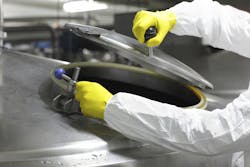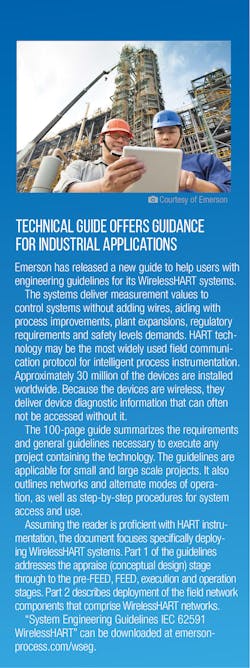Level measurement system yields greater accuracy
Over and over again, a biotech facility was unable to obtain repeatable liquid level measurements. As a result, the 60-foot vessel used for enzyme fermentation was creating inconsistent batch production at their Midwestern U.S. facility. Like many level measurement applications, a pressure-based technique was being used where the difference in pressure between the top and bottom of the tank inferred level.
Given consistent product density, pressure-based measurement will produce accurate and very repeatable readings, but as with all level solutions, application engineering is sometimes required for successful implementation. Such was the case at this facility.
Level measurement issues
The facility was experiencing recurring problems measuring level in a tall vessel used for enzyme fermentation, leading to inconsistent batch production.
The existing pressure measurement solution installed on the vessel included a differential pressure transmitter with a remote diaphragm seal on the high pressure tap at the bottom of the vessel, and impulse piping with a pneumatic repeater running from the top of the vessel to the low side of the transmitter.
A series of challenges contributed to the plant’s inability to get a repeatable measurement of the liquid level in the vessel:
- Agitators in the vessel turned the process over in 3 to 5 minutes, which induced rapidly fluctuating levels.
- The extremely slow response time of the existing measurement solution was suboptimal for level control.
- The use of a mechanical pneumatic repeater on such a tall vessel caused measurement errors that often exceeded 3 to 5 percent of span, with the readings frequently spiking.
This ERS level measurement system eliminates problems with traditional dP level measurement by linking the sensors digitally with an electrical cable.
The lack of a repeatable level measurement was an ongoing problem. Engineers double-checked measurements throughout the entire process, but without accurate level measurements on the fermenter vessel, it was impossible to accurately calculate yield. As a result, batch quality and throughput were inconsistent, and operation costs were unduly high.
Measuring level using pressure-based technology works well in many applications, making it the most widely used level measurement technique. In many other traditional applications including this one, impulse piping can cause measurement inaccuracy and ongoing maintenance issues.
In search of a solution, the plant turned to level experts for assistance.
Digital solution
After visiting the facility and examining the level measurement issues, Emerson Process Management staff recommended replacement of the existing instrumentation with its Rosemount 3051S Electronic Remote Sensors system. The system consists of two pressure sensors linked digitally via a standard electrical cable.
Differential pressure is computed in one of the sensors, and this and other measurement information are sent back to the control system through a single 4 to 20 milliamps (mA)/HART signal. Because wiring is only required from one of the sensors, there’s no need for additional wiring, control system inputs or reprogramming.
Once the new level measurement system was up and running, plant engineers and operators noticed a drastic improvement in response time, and they were able to accurately and quickly track changes in the vessel level that previously went unnoticed. Additionally, the measurement accuracy improved, with error decreasing from 3 to 5 percent to less than 0.5 percent of span.
By consistently measuring the level in the vessel, the facility is now able to produce more enzymes in the fermenters. "This vessel went from being our worst performing to our best," an instrument technician at the facility said.
Impulse line elimination
The system installed at the biotech facility eliminates the impulse line and addresses other issues by linking the two pressure sensors with a non-proprietary electrical cable. Either sensor can be designated to calculate differential pressure (dP) and level, and this data along with readings from each sensor can be sent back to the control system via a single 4 to 20 mA signal with HART digital information imposed.
No programming is needed at the control system to infer level because these calculations are made at either sensor, with the user selecting the "master" sensor at installation and configuration. No errors are introduced from changes in static pressure, and the system is easily zeroed and calibrated.
A dP level measurement system with a digital link between the pressure sensors can be less expensive to install than traditional two-transmitter solutions because no impulse line is needed, and because only one transmitter has to be wired back to the control system. When compared to dP measurement with an impulse line, a digital system yields more accurate and repeatable level measurement with quicker response time, along with reduced maintenance.
Nathan Stokes is a senior product manager for global Rosemount dP Level products with Emerson Process Management in Shakopee, Minnesota. Stokes holds a degree in mechanical engineering from the University of North Dakota and an MBA from the University of Minnesota.

